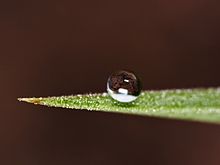
Back كاره للماء Arabic Hidrófobu AST Hidrofobluq Azerbaijani Hidrofòbia Catalan Hydrofob Danish Hydrophobie German Υδρόφοβος Greek Hidrofoba Esperanto Hidrófobo Spanish Hidrofobia Basque



In chemistry, hydrophobicity is the physical property of a molecule that is seemingly repelled from a mass of water (called a hydrophobe).[1] In contrast, hydrophiles are attracted to water.
Hydrophobic molecules tend to be nonpolar and, thus, prefer other neutral molecules and nonpolar solvents. Because water molecules are polar, hydrophobes do not dissolve well among them. Hydrophobic molecules in water often cluster together, forming micelles. Water on hydrophobic surfaces will exhibit a high contact angle.
Examples of hydrophobic molecules include the alkanes, oils, fats, and greasy substances in general. Hydrophobic materials are used for oil removal from water, the management of oil spills, and chemical separation processes to remove non-polar substances from polar compounds.[2]
Hydrophobic is often used interchangeably with lipophilic, "fat-loving". However, the two terms are not synonymous. While hydrophobic substances are usually lipophilic, there are exceptions, such as the silicones and fluorocarbons.[citation needed]
The term hydrophobe comes from the Ancient Greek ὑδρόφοβος (hydróphobos), "having a fear of water", constructed from Ancient Greek ὕδωρ (húdōr) 'water' and Ancient Greek φόβος (phóbos) 'fear'.[3]
- ^ Ben-Na'im, Aryeh. Hydrophobic Interaction. New York: Plenum Press. ISBN 0-306-40222-X.
- ^ Akhavan B, Jarvis K, Majewski P (November 2013). "Hydrophobic Plasma Polymer Coated Silica Particles for Petroleum Hydrocarbon Removal". ACS Appl. Mater. Interfaces. 5 (17): 8563–8571. doi:10.1021/am4020154. PMID 23942510.
- ^ Liddell, H.G. & Scott, R. (1940). A Greek-English Lexicon. revised and augmented throughout by Sir Henry Stuart Jones. with the assistance of. Roderick McKenzie. Oxford: Clarendon Press.